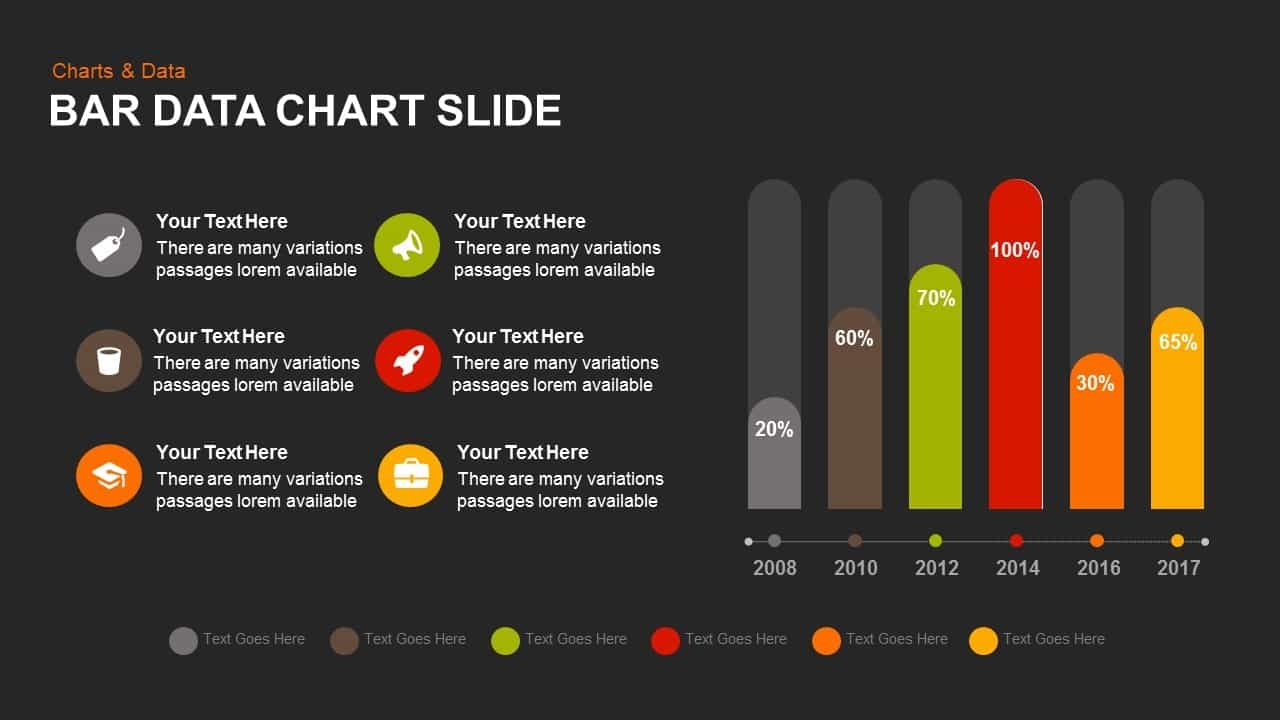Introduction to Bar Graphs
A bar graph, also known as a bar chart, is a visual representation of data using rectangular bars with heights or lengths proportional to the values they represent. Bar graphs are one of the most widely used and effective ways to display and compare different values or quantities.
The primary purpose of a bar graph is to illustrate the relationship between different categories and their corresponding values. This makes bar graphs particularly useful for displaying and analyzing data trends, making comparisons, and identifying patterns or outliers within a dataset.
Bar graphs are commonly used in various fields, including business, finance, economics, social sciences, and scientific research. They are an excellent choice when you need to present data in a clear, concise, and easily understandable manner, allowing viewers to quickly grasp the relative magnitudes and relationships between different data points.
Data Preparation
Proper data preparation is crucial for creating an effective and accurate bar graph. The first step is to identify the variables you want to represent and ensure your data is formatted correctly. In a bar graph, one variable is typically displayed on the x-axis (horizontal), while the other variable is shown on the y-axis (vertical).
For example, if you want to visualize sales data for different product categories, the product categories would be represented on the x-axis, and the sales figures would be plotted on the y-axis.
Once you’ve identified your variables, it’s essential to clean and organize your data. This may involve removing any irrelevant or redundant information, handling missing values, and ensuring consistency in data formatting.
If you’re working with raw data from multiple sources, you may need to consolidate it into a single dataset. Additionally, you should check for any errors or outliers that could skew your graph’s representation.
It’s also important to ensure that your data is sorted and arranged in a logical order, especially for the variable represented on the x-axis. This will make your bar graph easier to read and interpret.
Choosing the Right Software
When it comes to creating bar graphs, you have a variety of software options to choose from, each with its own strengths and capabilities. Here are some popular choices:
Microsoft Excel: Excel is a widely used spreadsheet software that offers robust charting and graphing features. It’s a great option for those who are already familiar with Excel or need to work with data stored in spreadsheets. Excel provides a user-friendly interface for creating bar graphs, along with various customization options.
Google Sheets: Google Sheets is a free, web-based spreadsheet application that offers similar functionality to Excel. It’s a convenient choice if you need to collaborate with others or access your data from multiple devices. Google Sheets’ charting tools are intuitive and allow you to create bar graphs directly from your data.
Python: Python is a versatile programming language that offers several data visualization libraries, such as Matplotlib and Plotly. While Python may have a steeper learning curve than spreadsheet software, it provides more flexibility and customization options for creating bar graphs. It’s an excellent choice for those with programming experience or working with large datasets.
R: R is a powerful statistical programming language that excels in data analysis and visualization. It offers several packages, like ggplot2 and plotly, that provide extensive capabilities for creating bar graphs. R is particularly useful for those working in the fields of statistics, data science, or research, where advanced data analysis is required.
Tableau: Tableau is a popular data visualization tool that allows you to create interactive and visually appealing bar graphs. It’s known for its user-friendly drag-and-drop interface and advanced analytical capabilities. Tableau is a great option for those who need to create professional-grade visualizations and share them with others.
The choice of software ultimately depends on your specific needs, familiarity with the tools, and the complexity of your data. Consider factors such as ease of use, available features, integration with other tools, and the learning curve involved.
Setting up the Graph
Creating a bar graph is a straightforward process in most data visualization software or spreadsheet applications. Here’s a step-by-step guide to setting up a bar graph:
-
Input Data: Start by entering your data into the software. This typically involves creating a table or spreadsheet with rows for each category or group, and columns for the corresponding values or measurements.
-
Select Data Range: Next, select the range of cells containing the data you want to visualize. This range should include the category labels and the corresponding values.
-
Create Bar Graph: Look for an option to create a new chart or graph, often found in a menu or toolbar. Select the “Bar Graph” or “Column Chart” option from the available chart types.
-
Customize Axes: Once the basic bar graph is generated, you can customize the axes to improve clarity and readability. Click on the horizontal (x) axis and provide a label that clearly describes the categories or groups represented. Similarly, click on the vertical (y) axis and label it with the unit of measurement or value being displayed.
Add Chart Title:
-
Give your bar graph a descriptive title that accurately represents the data being visualized. This title should be concise yet informative, helping viewers quickly understand the graph’s purpose.
-
Format Bars: Depending on your software, you may have options to change the color, pattern, or style of the bars. Choose colors or patterns that are visually distinct and easy to distinguish, especially if you have multiple data series or groups represented.
-
Add Legend (if needed): If your bar graph includes multiple data series or groups, consider adding a legend to explain what each bar color or pattern represents. The legend should be clear and easy to understand.
-
Adjust Scale and Gridlines: Review the scale of the vertical axis to ensure it accurately represents the range of values in your data. You can also add gridlines to the chart area to help viewers easily compare bar heights and estimate values.
-
Finalize Formatting: Once you’ve set up the essential elements, take a final look at the overall appearance of your bar graph. Adjust font sizes, colors, and other formatting options to ensure a clean and professional presentation.
By following these steps, you’ll create a well-structured and visually appealing bar graph that effectively communicates your data to your audience.
Customizing the Appearance
Customizing the appearance of your bar graph is crucial for creating a visually appealing and easy-to-understand representation of your data. By adjusting colors, fonts, gridlines, and other visual elements, you can enhance clarity and aesthetics, ensuring that your bar graph effectively communicates the intended message.
Colors: Colors play a significant role in making your bar graph stand out and convey meaning. Choose colors that contrast well with the background and are easy on the eyes. Consider using different colors to differentiate between categories or data sets. However, be mindful of color blindness and ensure that your color choices are accessible to all viewers.
Fonts: Select a font that is clean, legible, and consistent throughout your bar graph. Avoid using overly decorative or complex fonts, as they can be distracting and difficult to read. Adjust the font size and weight to ensure that labels and values are easily readable.
Gridlines:
Gridlines can help viewers interpret the data more accurately by providing a visual reference for values on the axes. Adjust the gridline style and color to ensure they are visible but not overpowering. Consider using dashed or lighter gridlines to avoid cluttering the graph.
Axis Labels and Titles: Clearly label your axes and provide a descriptive title for your bar graph.
Legend: If your bar graph includes multiple data sets or categories, include a legend to explain the meaning of each color or pattern used. Position the legend in a prominent and logical location, and ensure that it is easy to understand and interpret.
Data Labels: Consider adding data labels directly on the bars to provide precise values or percentages. This can be particularly helpful when the differences between bars are small or when exact values are important for analysis.
Aspect Ratio and Scaling: Adjust the aspect ratio and scaling of your bar graph to ensure that the bars are proportional and accurately represent the data. Avoid distorting the graph by stretching or squeezing it unnecessarily.
Background and Borders: Choose a clean and uncluttered background for your bar graph. Consider adding subtle borders or dividers to separate different sections or elements of the graph, but be careful not to overdo it and create visual clutter.
Remember, the goal of customizing the appearance is to enhance the clarity and effectiveness of your bar graph. Experiment with different visual elements and settings until you achieve a balanced and visually appealing representation of your data.
Interpreting the Data
A bar graph is an effective way to visualize and interpret data, allowing you to identify patterns, trends, and relationships at a glance. When interpreting a bar graph, it’s essential to understand the variables represented on the x-axis (horizontal) and y-axis (vertical), as well as the scale used for each axis.
The height or length of each bar corresponds to the value for that particular category.
To interpret the data effectively, follow these steps:
-
Identify the Variables: Understand what the x-axis and y-axis represent. The x-axis usually displays the categories or groups, while the y-axis shows the numerical values or measurements.
-
Examine the Scale: Pay attention to the scale used on the y-axis. Note the starting and ending values, as well as the intervals between each unit. This will help you accurately interpret the values represented by the bars.
Compare Bar Heights:
-
Look for the highest and lowest bars, which represent the categories with the maximum and minimum values, respectively. This can help you quickly identify the most significant differences or outliers in the data.
-
Identify Patterns and Trends: Scan the graph for any patterns or trends in the data. Are the bars increasing or decreasing in a particular order? Are there any clusters or gaps between groups of bars? These patterns can reveal valuable insights and relationships within the data.
-
Consider Relative Differences: While comparing the absolute values is important, also consider the relative differences between bars. A small difference in bar height may be significant if the overall values are small, or insignificant if the values are large.
-
Look for Outliers: Identify any bars that seem to deviate significantly from the rest of the data. Outliers can indicate anomalies, errors, or unique circumstances that may require further investigation.
-
Interpret the Context: Always interpret the data within the context of the subject matter or problem being analyzed. The meaning and implications of the patterns or trends you observe may vary depending on the specific context.
By carefully interpreting the information presented in a bar graph, you can gain valuable insights into the data, identify key relationships, and make informed decisions based on the patterns and trends revealed.
Best Practices and Tips
Effective Labeling: Ensure that your bar graph has clear and concise labels for the x-axis (categories) and y-axis (values). Use meaningful labels that accurately represent the data being displayed. Avoid ambiguous or confusing labels that could lead to misinterpretation.
Appropriate Scaling: Choose an appropriate scale for the y-axis that allows for easy interpretation of the data. If the data range is large, consider using a logarithmic scale or breaking the y-axis into multiple sections. Conversely, if the data range is small, use a scale that provides sufficient granularity.
Avoid Truncated Axes:
Truncating the y-axis (starting at a value other than zero) can distort the visual representation of the data and make differences between bars appear more extreme than they actually are. Unless there is a compelling reason, it’s best to start the y-axis at zero.
Use Clear and Contrasting Colors: Choose colors that are easily distinguishable and provide sufficient contrast between bars. Avoid using too many colors or colors that are too similar, as this can make the graph difficult to interpret. Consider using patterns or textures for additional differentiation if necessary.
Limit the Number of Bars: While bar graphs are effective for displaying categorical data, displaying too many bars can make the graph cluttered and difficult to read. If you have a large number of categories, consider grouping them or using an alternative visualization technique.
Provide Context: Include contextual information, such as the data source, time period, and any relevant notes or explanations, to help readers understand the data accurately.
Highlight Key Findings: If there are specific bars or patterns that you want to draw attention to, consider using annotations, arrows, or other visual cues to highlight them. However, be cautious not to overdo it and make the graph too busy.
Maintain Consistency: If you are creating multiple bar graphs for comparison or within a report, maintain consistency in terms of color schemes, labeling conventions, and overall design. This will make it easier for readers to interpret and compare the data across different graphs.
Consider Accessibility: When designing bar graphs, keep accessibility in mind. Use color combinations that are distinguishable for individuals with color vision deficiencies and provide alternative text descriptions for those using screen readers.
Use Cases and Examples
Bar graphs are widely used across various fields for data visualization and analysis. Here are some real-world scenarios and examples:
Business and Finance
- Sales reports: Bar graphs can display sales figures for different products, regions, or time periods, allowing for easy comparison and trend analysis.
- Marketing data: They can visualize website traffic, social media engagement, or campaign performance metrics.
- Financial reports: Bar graphs effectively represent revenue, expenses, profits, or losses across different categories or time frames.
Education and Research
- Student performance: Teachers can use bar graphs to illustrate class averages, individual scores, or progress over time.
- Survey results: Researchers often employ bar graphs to present survey data, making it easier to identify patterns and draw insights.
- Scientific experiments: Bar graphs can visualize the results of experiments, such as the effects of different treatments or variables on a measured outcome.
Healthcare and Medicine
- Patient data: Bar graphs can display patient demographics, disease prevalence, or treatment outcomes across different groups or locations.
- Clinical trials: They can represent the efficacy or side effects of various drugs or interventions in clinical studies.
- Public health: Bar graphs are useful for visualizing health statistics, such as disease rates, risk factors, or healthcare access across different populations.
Sports and Athletics
- Performance metrics: Bar graphs can illustrate individual or team statistics, such as points scored, wins/losses, or player rankings.
- Event analysis: They can represent data from sporting events, such as the number of participants, medal counts, or record-breaking performances.
Environmental and Sustainability
- Resource consumption: Bar graphs can visualize energy usage, water consumption, or waste generation across different sectors, regions, or time periods.
- Emissions data: They can represent greenhouse gas emissions, air pollution levels, or carbon footprints from various sources or activities.
- Conservation efforts: Bar graphs can illustrate the impact of conservation initiatives, such as changes in wildlife populations or deforestation rates.
These examples demonstrate the versatility of bar graphs in communicating quantitative information effectively across diverse fields and applications.
Limitations and Alternatives
Bar graphs are a versatile and widely-used data visualization tool, but they also have limitations that may make alternative visualizations more suitable in certain situations. Understanding these limitations can help you choose the most appropriate way to represent your data effectively.
For continuous data
One significant limitation of bar graphs is that they are primarily designed to display and compare discrete or categorical data. For continuous data or data with a large range of values, bar graphs can become cluttered and difficult to interpret, especially when there are many categories. In such cases, line graphs, scatter plots, or other visualizations that can better represent the continuity and distribution of the data may be more appropriate.
Another limitation is that bar graphs can be challenging to interpret when there are many categories or when the bars are too close together. This can lead to visual confusion and make it difficult to accurately compare values.
Bar graphs are also less effective at displaying complex relationships or patterns within the data. For example, if you need to show correlations, trends, or hierarchical structures, alternative visualizations like scatter plots, line graphs, or tree maps may be more suitable.
Additionally, bar graphs can be misleading if the scale or axis is not appropriately chosen or labeled. It’s essential to ensure that the scale accurately represents the data and that the axis labels are clear and unambiguous to avoid misinterpretation.
When deciding whether to use a bar graph or an alternative visualization, consider the nature of your data, the specific information you want to convey, and the audience you are presenting to. If your data is categorical or discrete, and you need to compare values across a limited number of categories, a bar graph may be an excellent choice. However, if your data is continuous, has a wide range of values, or involves complex relationships, explore alternative visualizations like line graphs, scatter plots, or more specialized charts that can better represent the nuances of your data.
Resources and Further Learning
For those looking to deepen their knowledge of data visualization and creating effective bar graphs, there are numerous resources available. Consider exploring online courses, tutorials, and books dedicated to data visualization principles and techniques. Many software platforms, such as Excel, Tableau, and Python libraries like Matplotlib, offer extensive documentation and user communities where you can find tips, best practices, and advanced techniques.
Additionally, websites and blogs maintained by data visualization experts and organizations can provide valuable insights, case studies, and updates on the latest trends and tools in the field. Attending conferences, webinars, or joining data visualization communities can also be beneficial for networking, learning from peers, and staying up-to-date with the ever-evolving landscape of data visualization.










